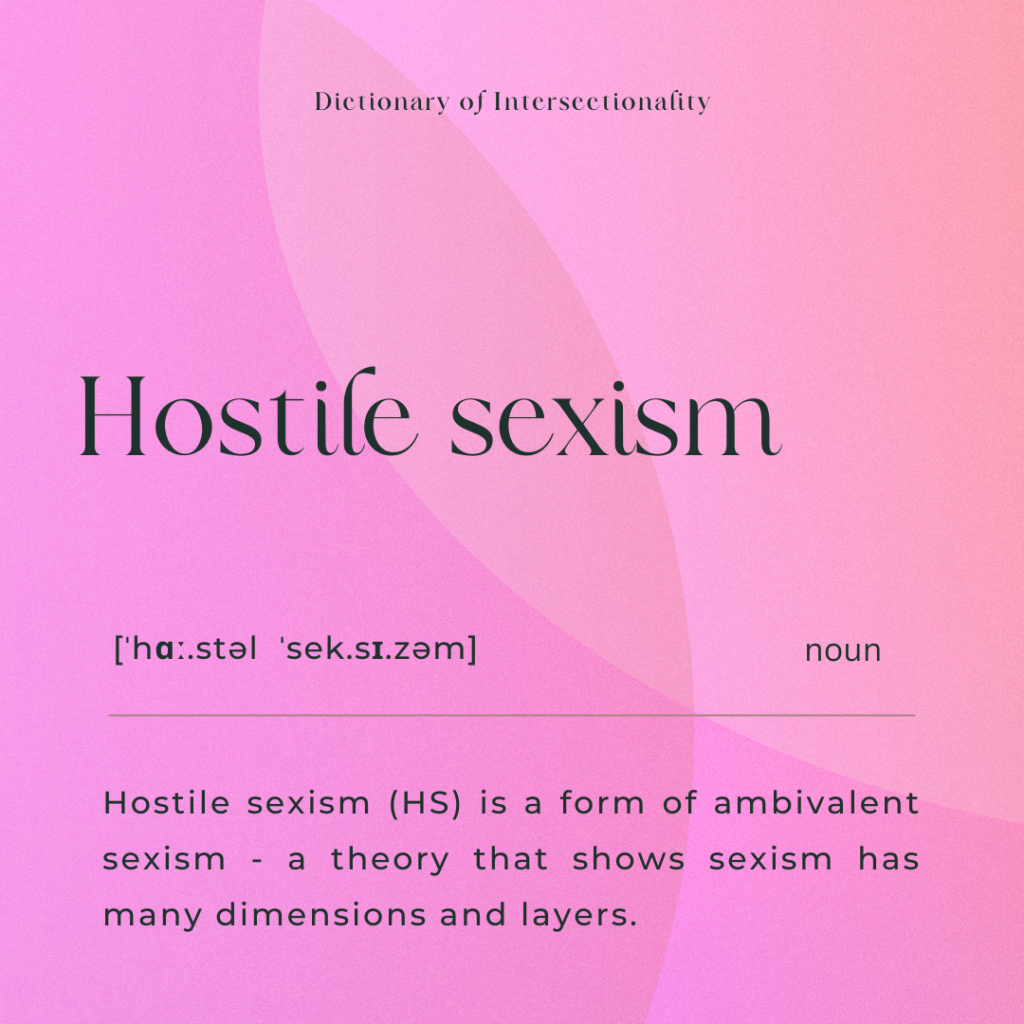
The theory of ambivalent sexism distinguishes between hostile sexism (HS) and benevolent sexism (BS).
Hostile sexism refers to the attitudes, beliefs and behaviours that are openly hostile toward a group of people based on their sex or gender. Common to both forms is a belief in the incompetence of women as an inferior group. In general, hostile sexism aligns with classical prejudice definitions, such as misogyny (the hatred of women by men) and the expression of obvious negative evaluations of women.
Hostile sexism can be traced to colonialism and slavery, where a group’s “lack of competence” legitimized domination without being seen as an exploitative structural power with self-serving justification. Due to its explicit nature, HS is more visible. Through the lenses of people who hold these hostile sexist assumptions, women (which may also apply to anyone with feminine traits and anyone who expresses their gender in a way that is associated with femininity) are seen as manipulative, deceitful, capable of using seduction to control men or needed to be kept in their place.
Three sub-dimensions of hostile sexism are dominative paternalism (justify patriarchy by viewing women as not fully competent adults), competitive gender differentiation (only men are perceived as having traits necessary to govern important social institutions), and heterosexual hostility (belief that women use their sexual allure to gain dominance over men). People who perpetuate hostile sexism want to preserve men’s dominance over women and people of other marginalized genders. They typically oppose gender equality and LGBTQIA+ rights, seeing these things as a threat to men and the systems that benefit them.
How to detect hostile sexism?
Common examples may be: using sexist language and insults, making threatening or aggressive comments based on a person’s gender or sex, harassing or threatening someone for defying gender norms (online or offline), treating people as subordinates based on their sex or gender and punishing them when they “step out of the line”, believing that victims of sexual assault “ask for it” due to their behaviour or clothing, or even engaging in physical or sexual assaults. Hostile sexism is a risk factor for sexual harassment, abuse in relationships, and gender-based violence.
There are also existing hostile ambivalences about men (NOT CALLED SEXSIM), such as the resentment of paternalism (e.g., men will always fight to have greater control in society than women), compensatory gender differentiation (e.g., men would be lost in this world if women weren’t there to guide them) or heterosexual hostility (e.g., a man who is sexually attracted to women typically has no morals about doing whatever it takes to get her to bed).
See more resources
Glick, P. & Fiske, S. T., (1996). The Ambivalent Sexism Inventory: Differentiating Hostile and Benevolent Sexism. Journal of Personality and Social Psychology. Vol. 70, No. 3, 491-512.
Glick, P., & Hilt, L. (2000). Combative children to ambivalent adults: The development of gender prejudice. In T. Eckes & H. Trautner (Eds.), The Developmental Social Psychology of Gender (pp. 243–272). Mahwah: Lawrence Erlbaum Associates.
Retrieved 03.04.2023, from https://www.dictionary.com/browse/ambivalent-sexism
Retrieved 04.04.2023, from https://www.medicalnewstoday.com/articles/types-of-sexism#benevolent
